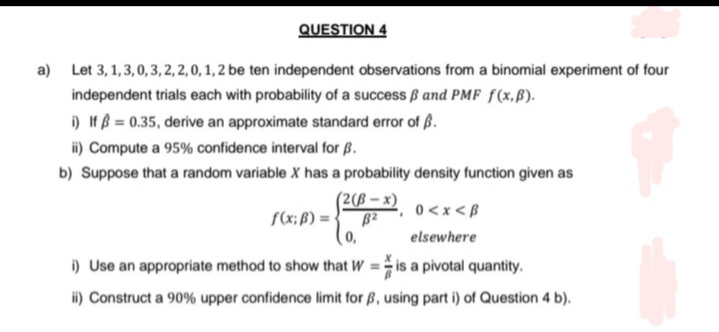QUESTION 4 a) Let 3, 1,3,0,3,2,2,0, 1, 2 be ten independent observations from a binomial experiment of four independent trials each with probability of a success ß and PMF f(x,B). i) If = 0.35, derive an approximate standard error of B. ii) Compute a 95% confidence interval for B.
QUESTION 4 a) Let 3, 1,3,0,3,2,2,0, 1, 2 be ten independent observations from a binomial experiment of four independent trials each with probability of a success ß and PMF f(x,B). i) If = 0.35, derive an approximate standard error of B. ii) Compute a 95% confidence interval for B.
Algebra & Trigonometry with Analytic Geometry
13th Edition
ISBN:9781133382119
Author:Swokowski
Publisher:Swokowski
Chapter10: Sequences, Series, And Probability
Section10.8: Probability
Problem 19E
Related questions
Question

Transcribed Image Text:QUESTION 4
a) Let 3, 1,3,0,3, 2, 2, 0, 1, 2 be ten independent observations from a binomial experiment of four
independent trials each with probability of a success ß and PMF f(x,B).
i) If = 0.35, derive an approximate standard error of B.
ii) Compute a 95% confidence interval for B.
b) Suppose that a random variable X has a probability density function given as
(2(B-x)
0<x<B
elsewhere
i) Use an appropriate method to show that W =
is a pivotal quantity.
ii) Construct a 90% upper confidence limit for B, using part i) of Question 4 b).
f(x; B) = B2
Expert Solution
This question has been solved!
Explore an expertly crafted, step-by-step solution for a thorough understanding of key concepts.
Step by step
Solved in 3 steps with 2 images

Recommended textbooks for you

Algebra & Trigonometry with Analytic Geometry
Algebra
ISBN:
9781133382119
Author:
Swokowski
Publisher:
Cengage

Algebra & Trigonometry with Analytic Geometry
Algebra
ISBN:
9781133382119
Author:
Swokowski
Publisher:
Cengage